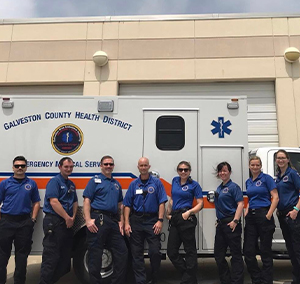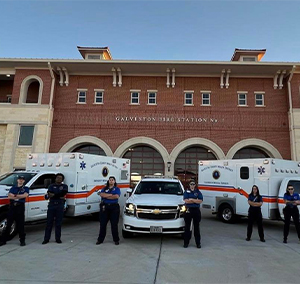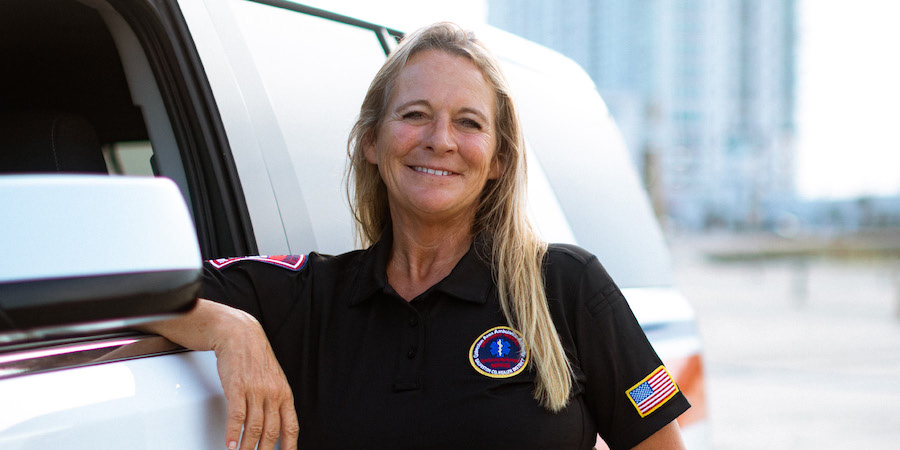Amy Weber was 23 when she arrived in Galveston from Michigan. The warm weather lured her to the island. She took a CPR class and met new friends, and one of them invited her on a ride-along with Galveston EMS.
“They let us do ride-alongs 20-something years ago,” she said.
“I wanted to see if it was for me. Then we ran a cardiac arrest. The crew was really impressive. They were calm and collected and showed great scene management. They allowed me to do CPR, and that was the start that hooked me. I was like, ‘Oh, this is it. If I can make a difference in somebody’s life, this is it.’”
Weber joined the agency in 1997 and never left.

She is now the EMS chief for the Galveston County Health District. In this role, she oversees the health district’s Galveston County Area Ambulance Authority, which has 90 employees and covers 156 square miles, including rural and urban areas, beaches and waterways surrounding Galveston County. Weber oversees stations in Bacliff, Kemah, Galveston and Hitchcock.
Weber became director of EMS for the health district in 2018 and has been with the agency for more than 25 years. She started as an EMT, then she went back to school to become a paramedic. She moved up to supervisor, then to operations manager and then to interim director for a few months before becoming chief.
“It’s like a beautiful dance between medicine, politics, budgets and taking care of the crews,” Weber said. “You do the best you can. I would like to be out there with the crews more.”
Finding and hiring more emergency medics is a challenge for Weber.
“There’s a shortage, and they can make more money working in different medical areas outside of the pre-hospital setting,” she said.
The health district offers sign-on bonuses for the Galveston Area Ambulance Authority also often referred to as Galveston EMS or GEMS.
It’s just one of many ongoing challenges she has. Others include pushing for more training and research studies, reducing burnout in crews, and continuing a pattern of improving care.
“I have an amazing team, period,” she said. “They are a great group of people who are very family-oriented in their EMS community. From in the office to in the field, every one of these employees are unique, and they’re all amazing. That’s always a nice thing to have. They all have unique skills, and we are working together as a team.”
A less-experienced medical staff member can work with and learn from an experienced medical member to adapt to the fast pace of EMS.
Weber also keeps her employees’ well-being a priority.

“I’m always looking for ways to reduce injuries or help save preventable injuries,” Weber said. “The physical aspects wear you down pretty good. We do live where everywhere is upstairs.”
To reduce burnout, the agency tries to schedule a medic to work on Galveston Island one day and then put that person at a slower station in the county the next day. That’s because island crews run between 15 to 20 calls a day.
Education
Galveston Area Ambulance Authority emphasizes education for its crews, as does Weber.
“We’re looking for evidence-based medicine to improve services to the county and make a difference in the lives of everybody who lives in our area,” she said.
The EMS agency offers several continuing-education classes every month. It has also implemented certificate training for Pediatric Advanced Life Support (PALS), Advanced Cardiac Life Support (ACLS) and CPR along with other programs.
The agency covers the cost for employees with the in-house training. And their ongoing education goes beyond what’s required to include specific needs of the crews and the agency.
“We look at those calls that we don’t run that often and talk about how we can educate the crews and get them more comfortable with the continuing changes within the EMS industry,” Weber said.
To do that takes muscle memory, not just brain knowledge. Online training plus hands-on practice helps the crews get both.
Much of the training at the Galveston Area Ambulance Authority is quality-assurance driven. When the team assesses quality assurance, they can see what training the crews might lack. Then the training officer builds a program to improve that knowledge and skills.
LUCAS devices
This year, the agency improved its rate of spontaneous circulation (ROSC) numbers. Part of that might be about the pandemic ending, but the introduction of epinephrine drip IVs in the field paired with the help of a new mechanical CPR device has drastically shown a vast improvement, Weber said.
Those devices are called Lund University Cardiopulmonary Assist System devices, or as most medical staff refers to them: LUCAS devices. Earlier this year, the health district acquired 11 LUCAS devices.
“With the introduction of the epinephrine drip and the LUCAS devices, we are seeing what a difference we are making,” Weber said. “We’re looking at an 81.2% ROSC grade, which is phenomenal.”
Researchers at UTMB Health are studying the ROSC numbers on the agency’s cases using epinephrine drip IVs. Weber gets feedback about the patients.
“If we can make a difference and have them walking and talking and taking care of themselves, that’s the best option,” Weber said. “We need to do more studies and push emergency medicine to the forefront instead of it being seen as agencies that just pick up people.”
She’s also gathering data on results from the LUCAS devices.
“It’s something in the medical field to be recognized for what you’re doing in EMS, but I don’t want to be published just for some numbers,” Weber said. “I want to make a difference in somebody’s life in our community. If somebody reaches out to us and says, ‘Hey, I love what you’re doing. Can you share your protocol,’ we would.”
The agency also receives continuous feedback for the use of antibiotics in the field for trauma emergencies. Other EMS agencies have reached out to Weber to learn more about their protocols for improvements.
“We administer it for open fractures, but we’ve even expanded it to any break in the skin from a traumatic event because we’re seeing infections there, too,” she said.
“This is the encouraging information that I would like to leave behind for the next group of excited and curious medical providers to push farther to grow this industry higher to finally gain the recognition that is deserved with EMS,” Weber said.
